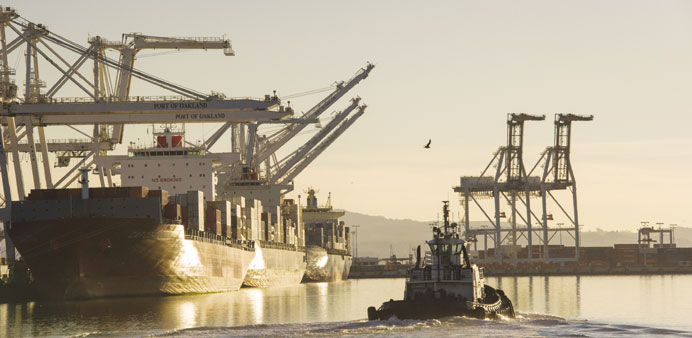A tug boat heads out to retrieve a container ship at the Port of Oakland in California. The US gross domestic product expanded at a 2.2% annual rate, the Commerce Department said yesterday in its third estimate.
Reuters/Washington
US economic growth cooled in the fourth quarter as previously reported and after-tax corporate profits took a hit from a strong dollar, which could undermine future business spending.
Gross domestic product expanded at a 2.2% annual rate, the Commerce Department said yesterday in its third estimate of GDP. That was unrevised from the forecast the government published last month.
Businesses throttled back on inventory and equipment investment, but robust consumer spending limited the slowdown in the pace of activity. The economy grew at a 5% rate in the third quarter.
After-tax corporate profits declined at a 1.6% rate last quarter after increasing at a 4.7% pace in the third quarter. Corporate profits from outside the US fell at an 8.8% rate, the steepest decline since the 2007-2009 recession.
“Slower profit growth could mean slower investment in the coming months,” said Thomas Costerg, an economist at Standard Chartered in New York.
Multinationals such as technology giant IBM, semiconductor maker Intel Corp, industrial conglomerate Honeywell and Procter & Gamble, the world’s largest household products maker, have warned that the dollar will hurt their profits this year.
The dollar gained 7.8% against the currencies of the main US trading partners between June and December.
For all of 2014, after-tax corporate profits fell 8.3%, the largest annual drop since 2008.
Economists had expected fourth-quarter GDP growth would be revised up to a 2.4% rate and after-tax corporate profits would rise at a 1% pace.
US stocks were trading marginally higher, as investors bet that the weak growth data would delay a Federal Reserve interest rate increase until later in 2015. The dollar dipped against a basket of currencies, while prices for US Treasuries rose.
A separate report showed consumer sentiment slipped in March, adding to signs that the moderate pace of economic expansion persisted through the first quarter.
The University of Michigan said its consumer sentiment index fell to 93 this month from a reading of 95.4 in February.
The sturdy dollar, lingering weakness in Europe and Asia, harsh winter weather in the US and a now-settled labour dispute at busy US West Coast ports dampened activity in the first two months of the year.
With temperatures rising, there are signs of some pick-up in activity. But the dollar will likely provide a challenge for domestic manufacturers. First-quarter growth estimates range between a 0.9% and 1.4% rate. “The impact of dollar strength and energy price declines may prove too much for GDP to hit the long-awaited 3% threshold in 2015, leaving another year of mid-2% growth in its wake,” said Jay Morelock, an economist at FTN Financial in New York.
Businesses accumulated $80bn worth of inventory in the fourth quarter, less than the $88.4bn the government had estimated last month.
As a result, inventories subtracted 0.10 percentage point from GDP growth in the fourth quarter. Restocking was previously reported to have added 0.1 percentage point to output.
The weak pace of restocking, however, removes the threat of an inventory overhang, giving businesses scope to place more orders for goods, which should help to stimulate manufacturing. Business investment on equipment was revised to show it rising at a 0.6% rate instead of the previously reported 0.9% pace, likely reflecting the impact of the strong dollar and lower crude oil prices, which have caused a drop in drilling and exploration activity.
But consumer spending, which accounts for more than two-thirds of US economic activity, increased at a 4.4% rate in the fourth quarter instead of the 4.2% rate reported last month. It was the fastest pace since the first quarter of 2006. Consumer spending, however, moderated early in the first quarter as cold and snowy weather kept shoppers at home. Households also appear to have opted to save the bulk of their savings from lower gasoline prices.
Despite slower global demand, export growth was revised higher. But with consumer spending so strong, more imports than previously estimated flowed into the country, resulting in a trade deficit that weighed on GDP growth.
Trade lopped off 1.03 percentage points instead of the 1.15 points reported last month.



